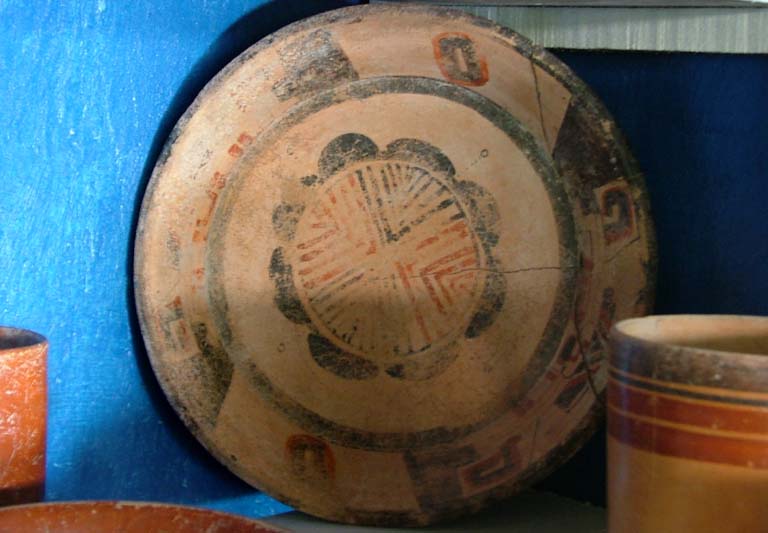El Chiclero Pottery Museum


The pottery in this section comes from the El Chiclero Pottery Museum at Uaxactun. These pots were collected by the Uaxactun Chicleros from a large number of sites in the area. Both Nikolai Grube and Sofia Paredes have documented the collection and their reports are available at the museum.


"This style group is characterized by the image of a dancing male figure who always is depicted wearing an elaborate feathered backrack. His clothing and headdress identify him as the Young Maize God, in whose guise the soul of a deceased person dances out of the underworld after defeating the Lords of Death.
This image is standard fare for funerary vessels, implying that the many plates created in this style were made to be placed in tombs."
Dorie Reents-Budet, Painting the Maya Universe: Royal Ceramics of the Classic Period, p. 339

"Functionally, these plates are excellent candidates for single-use funerary items to hold food or other offerings for the dead... Many of these plates exhibit little or no wear and some have a 'kill hole' poked through their centers, ostensibly to free the plate's spirit prior to internment. Yet three points argue against this single function.
First, some plate's interiors are hightly eroded, implying their use by the living as service vessels.
Second, many Dancer plate sherds have been excavated from nonfunerary contexts at Tikal, Ramonal, Uaxactun and El Zotz'.
Third, Tikal Dancer plates are painted with the same dancer imagery that characterizes the majority of Holmul-style vessels whose extrafunerary function as social currency and elite service ware is documented through archaeological and use-wear evidence.
The excavation of Tikal Dancer plates at other sites in the central Petén points to a similar ceramic exchange that, in some cases, may be characterized as social currency function. Therefore, it is probable that, even though the Tikal Dancer plates' primary use may have been as a funerary ware, this does not preclude ancillary preburial use."
Dorie Reents-Budet, Painting the Maya Universe: Royal Ceramics of the Classic Period, p. 198

This piece probably dates from the early decades of the Late Classic Period and is representative of what has been called the Tikal Dancer plate style.
Dorie Reents-Budet writes: "It has been suggested that these Dancer plates were produced at Tikal and nearyby Uaxactún or only at Tikal. The stylistic variations within the corpus point to multiple workshops, each expressing their individuality through minor yet consistent variations in the use of pictorial space, in iconography and in vessel shape.
When compared chemically to the corpus of lowland classic period polychrome pottery, these plates cluster together based on their similar compositional profiles and chemically resemble pottery excavated from the Tikal area. However, the groups's internal chemical diversity points not only to Tikal but also to smaller subsidiary sites within the greater Tikal sphere as the locations of the workshops where these plates were created."
Dorie Reents-Budet, Painting the Maya Universe: Royal Ceramics of the Classic Period, p. 197

"The motion of the dance is represented by the figure's raised leg with bent knee, outflung arms and flying loincloth ends.
Usually the figure is surrounded by a circular band that abuts the wall of the plate, the band painted a solid red color or with simple geometric motifs. More elaborate bands are decorated with jaguar pelt designs or hieroglyphs."
Dorie Reents-Budet, Painting the Maya Universe: Royal Ceramics of the Classic Period, p. 197

This fragment of a vase is in the Holmul-style, named for the archaeological site of Holmul, located in eastern Guatemala, where similar vases were first excavated archaeologically in 1911.
"Scores of vessels have since appeared, which are painted in a similar palette and with the same image of a dancing lord wearing an elaborate backrack. The variability in the depictions of the dancers, the degree of elaborateness of their costumes and the hand-writing differences noted in the hieroglyphic texts suggest that many workshops from many sites in one region were creating vessels in this style.
Most Holmul-style vessels are characterized by less-accomplished brush work and pictorial compositional abilities...This lesser quality suggests that these vessels were intended for a broader segment of Maya society lying outside the uppermost elite, a segment whose social and economic positions did not provide the mechanisms for acquiring finely painted and personalized elite wares.
The large quantity of this pottery correlates with the far greater numbers of people occupying the intermediary elite and even lower echelon of Maya sociey, in contrast to those few at the pinnacle of power. The majority of the Holmul-style vessels probably were created for these consumers, who may be considered as the Classic Period version of a middle class."
Dorie Reents-Budet, Painting the Maya Universe: Royal Ceramics of the Classic Period, p. 337 & 184


When there is a band of glyphs around the lip of a cup or the perimeter of a plate, it is usually a formulaic text which Michael Coe named the "Primary Standard Sequence" which describes the function of the vessel and associates it with either ownership or with the scribe who created it.
In short, it is an elaborate name tag which refers to characteristics of the vessel and its use and associates it with an owner or creator.
Stephen D. Houston, David Stuart & Karl A. Taube. American Anthropologist, vol 91, 1988. p. 720–26

Although badly weathered, this plate clearly shows a befeathered dancer












